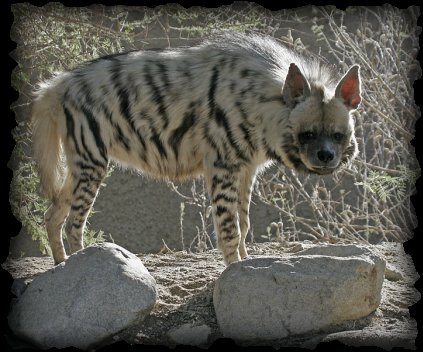
Imagine a world without the striped hyena. It might feel a bit like removing a puzzle piece that just doesn’t fit anywhere else. Striped hyenas help keep nature in balance by controlling populations of carrion and smaller animals. However, their habitats are shrinking, and they’re increasingly caught in the crossfire of human activities. Let me explain what’s happening and how we can all chip in to help these remarkable creatures.
Understanding the Striped Hyena
The striped hyena (Hyaena hyaena) is one of the four species of hyenas, and let me tell you, they have some unique characteristics. Unlike their more famous spotted cousins, striped hyenas tend to have a slender body with a scruffy coat, dominated by stripes, which is where they get their name. They are mostly solitary animals, often roaming alone or in small family groups, which is quite different from the pack dynamics of other hyena species.
These hyenas are mostly nocturnal, which means you’ll typically find them prowling around in the dark, scavenging for food. They primarily feed on carrion but will also munch on fruits, insects, and small mammals if they get the chance. It’s not just about surviving; they play a vital role in their ecosystem by cleaning up dead animals, helping prevent the spread of disease. So, you might be wondering, what’s threatening their existence?
Threats to the Striped Hyena Population
Honestly, the striped hyena faces several significant threats that endanger their survival. One of the biggest issues is habitat loss. As human populations expand, their natural homes are being destroyed for agriculture, urban development, and infrastructure projects. This leaves striped hyenas with fewer places to live and hunt, pushing them closer to the edge.
In addition to habitat loss, these hyenas are often victims of persecution. Farmers sometimes view them as pests because they might prey on livestock or compete for food. Unfortunately, this leads to hunting and trapping as a means of control. Striped hyenas are also at risk from road accidents due to their nocturnal nature and the increasing number of vehicles on the roads, creating a perfect storm for tragedy.
Conservation Status
As of now, the striped hyena is classified as “Near Threatened” by the IUCN Red List. This means that while they are not critically endangered, their numbers are declining, and they could face more serious threats if conservation efforts aren’t ramped up. What does this look like in numbers? It’s estimated that there are fewer than 10,000 striped hyenas left in the wild, and their population is fragmented across several countries in Africa and parts of Asia.
Here’s the thing: even a small decline in their numbers can have ripple effects on the ecosystem. With fewer scavengers around, the dead animal population can increase, leading to bigger challenges for other species and even potential health risks for humans. Understanding their status helps raise awareness and encourages action.
Current Conservation Efforts
Several initiatives are in motion to protect the striped hyena’s habitat and ensure their survival. Conservation organizations are working to educate local communities about the ecological benefits of hyenas. They believe that when people understand the important role these animals play, they’re more likely to protect them instead of viewing them solely as pests.
Additionally, some projects focus on creating protected areas where striped hyenas can thrive without the threat of human expansion. These areas often include reserves and parks where various wildlife can cohabit, helping create a balanced ecosystem. Through collaboration with local governments and communities, these efforts aim to ensure that striped hyenas not only survive but thrive.
How You Can Help
You might be thinking, “What can I do to help?” There are plenty of small steps you can take to contribute to the conservation of striped hyenas and wildlife in general. Here are a few ideas:
- Educate Yourself and Others: The more you know, the better you can spread awareness about the plight of striped hyenas.
- Support Conservation Organizations: Look for reliable organizations focusing on wildlife conservation and see how you can contribute through donations or volunteering.
- Advocate for Wildlife-Friendly Policies: Engage in local or national discussions about wildlife protection, and push for policies that prioritize conservation efforts.
- Responsible Tourism: If you travel to areas where striped hyenas live, choose eco-friendly tours that support local conservation efforts.
Taking even small actions can create a ripple effect that drives change and raises awareness.
The Bigger Picture: Biodiversity and Ecosystem Health
When we talk about conservation, it’s not just about saving one species. It’s about preserving entire ecosystems. Striped hyenas, with their scavenging habits, contribute to the health of their environment. They help control the spread of disease and maintain the balance between species. Losing them can lead to unpredictable consequences for other animals and plants in the food web.
Caring for striped hyenas means caring for the intricate and beautiful web of life connected to them. It emphasizes the importance of biodiversity and protecting habitats that all creatures—including humans—depend on.
So, is the striped hyena endangered? While they’re currently classified as near threatened, it’s crucial to recognize the ongoing challenges they face. By understanding their role in the ecosystem and supporting conservation efforts, we can make a difference in their survival. Remember, every little action counts. Whether it’s educating the next person or supporting initiatives that protect these remarkable animals, we all have a part to play in keeping the world a little wilder and a lot healthier. Let’s ensure that future generations get to enjoy the laughter of the striped hyena in the wild, serving their vital role in the circle of life.
